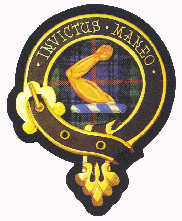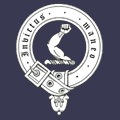 |
|---|
 |
|---|

The Armstrong's are a significant border clan whose origins lie in Cumberland, south of the frontier between Scotland and England that was officially established in 1237. The Armstrong name has a mythological origin, in that it is said their heroic progenitor, Fairbairn, saves his king of Scotland in battle, and not from a wild beast as is the case with another Border clan - the Turnbulls. It is said that, dressed in full armour, he lifted the king onto his own horse with one arm after the King's horse had been killed under him in battle. The family crest records this act of heroism that was to be rewarded with a grant of lands in the Borders and the famous Armstrong name.
The first specific reference locating them in Liddesdale, that would become their family seat, is in 1376. It was also the seat of their unquestioned power in the region that allowed them to expand into Annadale and Eskdale to accommodate their growing population. It is reputed that, by 1528, they were able to put 3000 horsemen in the field.
The Armstrong's relationship with subsequent Scottish kings was turbulent to say the least. The most notorious event in this uneasy relationship occurred in 1530. John Armstrong, known in history as 'Gilnockie', was persuaded to attend a meeting at Carlingrigg with King James V who, unknown to Gilnockie, had the malicious intent to silence the rebellious Borderers. The ruse succeeded as Gilnockie and fifty followers were captured. The Royal order to hang them was issued and despite several pleas for the King to lenient in exchange for obedience, it was carried out. Defiant to the last, Gilnockie said these words directly to King James V:
 The union of the Crowns in 1603 brought an official end to the Anglo-Scottish border wars and the last
of the Armstrong lairds was hanged in Edinburgh in 1610 for leading a reiving raid on Penrith. A ruthless
campaign followed as the Crown attempted to pacify the Borders. The families were scattered and many sought
new homes in Ulster, particularly in Fermanagh. Armstrong is now among the fifty most common Ulster surnames.
The union of the Crowns in 1603 brought an official end to the Anglo-Scottish border wars and the last
of the Armstrong lairds was hanged in Edinburgh in 1610 for leading a reiving raid on Penrith. A ruthless
campaign followed as the Crown attempted to pacify the Borders. The families were scattered and many sought
new homes in Ulster, particularly in Fermanagh. Armstrong is now among the fifty most common Ulster surnames.
The clan's authority resided intact at Mangerton in Liddesdale, a succession of Armstrongs retaining the 'Laird of Mangerton' title, until 1610 when Archibald Armstrong was 'put to the horn' as a rebel. After this, the Armstrong lands passed into the hands of the Scotts. There has been no trace of the Armstrong chiefs since the dispersal of the clan in the seventeenth century, but a powerful and active clan association is in existence and the Clan Armstrong Trust was established in 1978.
There have been many distinguished Armstrong's, including Sir Alexander Armstrong, the Arctic explorer and, in keeping with the Armstrong spirit of adventure, the most far-travelled must be Neil Armstrong, the first man to walk upon the moon.
 Armstrong Tartan
Armstrong Tartan
 |
|---|


